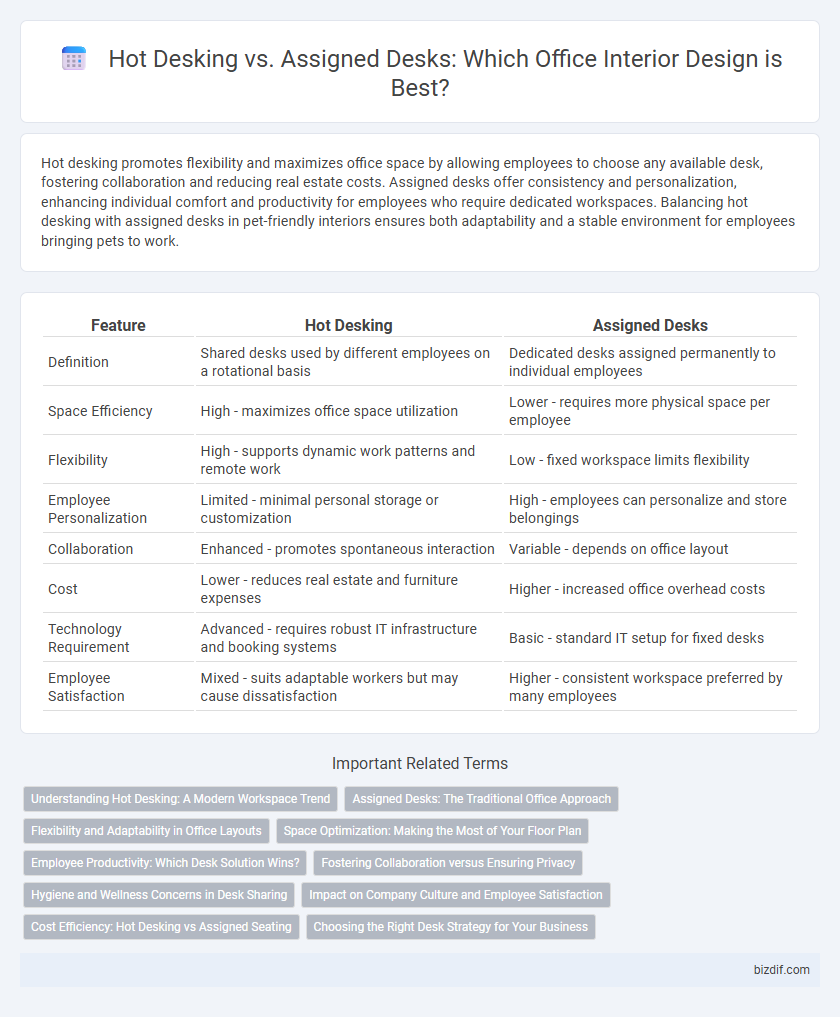Hot desking promotes flexibility and maximizes office space by allowing employees to choose any available desk, fostering collaboration and reducing real estate costs. Assigned desks offer consistency and personalization, enhancing individual comfort and productivity for employees who require dedicated workspaces. Balancing hot desking with assigned desks in pet-friendly interiors ensures both adaptability and a stable environment for employees bringing pets to work.
Table of Comparison
| Feature | Hot Desking | Assigned Desks |
|---|---|---|
| Definition | Shared desks used by different employees on a rotational basis | Dedicated desks assigned permanently to individual employees |
| Space Efficiency | High - maximizes office space utilization | Lower - requires more physical space per employee |
| Flexibility | High - supports dynamic work patterns and remote work | Low - fixed workspace limits flexibility |
| Employee Personalization | Limited - minimal personal storage or customization | High - employees can personalize and store belongings |
| Collaboration | Enhanced - promotes spontaneous interaction | Variable - depends on office layout |
| Cost | Lower - reduces real estate and furniture expenses | Higher - increased office overhead costs |
| Technology Requirement | Advanced - requires robust IT infrastructure and booking systems | Basic - standard IT setup for fixed desks |
| Employee Satisfaction | Mixed - suits adaptable workers but may cause dissatisfaction | Higher - consistent workspace preferred by many employees |
Understanding Hot Desking: A Modern Workspace Trend
Hot desking is a flexible office arrangement where employees do not have fixed desks but choose available workspaces daily, promoting efficient use of office real estate and enhancing collaboration. This modern workspace trend supports dynamic teams and remote work integration by allowing seamless adaptability to changing workforce needs. Companies adopting hot desking report increased space utilization rates and reduced overhead costs compared to traditional assigned desk setups.
Assigned Desks: The Traditional Office Approach
Assigned desks offer employees a consistent, personalized workspace that enhances organizational stability and individual productivity in traditional office settings. This approach supports clear territory ownership, reduces distractions, and fosters team collaboration by maintaining physical proximity. While requiring higher space allocation, assigned desks align with conventional office cultures valuing routine and employee comfort.
Flexibility and Adaptability in Office Layouts
Hot desking enhances flexibility and adaptability in office layouts by allowing employees to choose different workstations daily, optimizing space utilization and supporting dynamic collaboration. Assigned desks provide stability and personal space but limit the ability to adjust layouts quickly to changing team sizes or project needs. Embracing hot desking can lead to a more agile and efficient workspace that evolves with organizational demands.
Space Optimization: Making the Most of Your Floor Plan
Hot desking maximizes space optimization by allowing multiple employees to share a single workstation, reducing the overall footprint required for desks and freeing up valuable floor space for collaborative areas or additional amenities. Assigned desks allocate fixed workspaces to individuals, often resulting in underused areas during remote work or flexible schedules, which limits the efficient use of office real estate. Implementing hot desking supports dynamic space utilization, promoting a flexible floor plan that adapts to varying workforce densities and boosts overall office productivity.
Employee Productivity: Which Desk Solution Wins?
Hot desking fosters increased employee productivity by promoting flexibility, collaboration, and efficient space utilization, which can lead to enhanced creativity and reduced distractions. Assigned desks provide stability and personalization, allowing employees to create organized workspaces tailored to their needs, supporting sustained focus and comfort. Businesses aiming to maximize productivity should weigh the dynamic benefits of hot desking against the consistency offered by assigned desks, considering their workforce preferences and job requirements.
Fostering Collaboration versus Ensuring Privacy
Hot desking promotes collaboration by enabling employees to interact flexibly across various workstations, fostering spontaneous communication and teamwork. Assigned desks ensure privacy by providing personalized, consistent spaces that support focused, uninterrupted work and concentration. Balancing hot desking and assigned desks optimizes both dynamic collaboration and individual productivity in interior design planning.
Hygiene and Wellness Concerns in Desk Sharing
Hot desking promotes higher hygiene risks due to multiple users sharing the same workspace, increasing the likelihood of germ transmission. Assigned desks reduce cross-contamination by limiting the number of individuals using a single desk, supporting wellness through a consistent personal environment. Implementing sanitation protocols and ergonomic furniture enhances health outcomes regardless of the desk-sharing model.
Impact on Company Culture and Employee Satisfaction
Hot desking promotes a dynamic, collaborative company culture by encouraging employees to interact across departments, which can increase innovation and team cohesion. Assigned desks foster stability and a sense of ownership, contributing to employee satisfaction through personalization and routine. Balancing both approaches allows organizations to optimize flexibility while maintaining a supportive work environment, enhancing overall productivity and morale.
Cost Efficiency: Hot Desking vs Assigned Seating
Hot desking significantly reduces office space costs by maximizing workstation utilization, allowing companies to accommodate more employees within fewer square feet compared to assigned desks. Assigned seating increases expenses due to the need for additional furniture, personal storage, and larger office footprints to provide individual spaces for each employee. Businesses adopting hot desking can cut real estate costs by up to 30%, optimizing budget allocation for other interior design elements.
Choosing the Right Desk Strategy for Your Business
Hot desking maximizes office space efficiency by allowing employees to share desks based on availability, promoting flexibility and collaboration in dynamic work environments. Assigned desks provide personalized workspaces that enhance employee comfort and productivity through consistent use and personalization. Selecting the right desk strategy depends on factors such as company culture, team collaboration needs, office size, and employee preferences to optimize workflow and satisfaction.
Hot desking vs assigned desks Infographic

 bizdif.com
bizdif.com